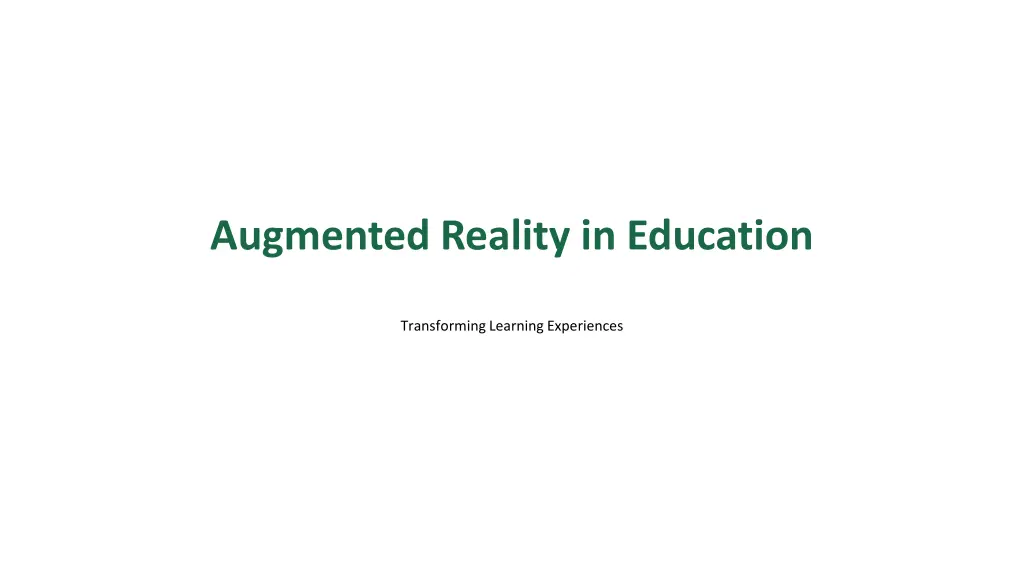
Revolutionizing Education Through Augmented Reality
Discover how Augmented Reality (AR) is transforming the educational landscape, enhancing engagement, improving visualization, boosting motivation and confidence, enabling differentiated instruction, and offering cost-effective solutions. Explore interactive learning experiences, 3D models, personalized teaching methods, and inclusive education practices. Uncover the potential of AR in shaping the future of learning.
Download Presentation

Please find below an Image/Link to download the presentation.
The content on the website is provided AS IS for your information and personal use only. It may not be sold, licensed, or shared on other websites without obtaining consent from the author. If you encounter any issues during the download, it is possible that the publisher has removed the file from their server.
You are allowed to download the files provided on this website for personal or commercial use, subject to the condition that they are used lawfully. All files are the property of their respective owners.
The content on the website is provided AS IS for your information and personal use only. It may not be sold, licensed, or shared on other websites without obtaining consent from the author.
E N D
Presentation Transcript
Augmented Reality in Education Transforming Learning Experiences
01 Introduction to Augmented Reality Table of Contents 02 Enhanced Engagement 03 Improved Visualization 04 Motivation and Confidence 05 Differentiated Instruction 06 Cost-Effectiveness 07 Challenges and Considerations 08 Case Studies 09 Implementing AR in Schools 10 The Future of AR in Education
1 Introduction to Augmented Reality An interactive experience where digital elements are overlaid on the real world. Explore the evolution of AR from its inception to modern-dayapplications. Understanding the differences between Augmented Reality and Virtual Reality. Discover the latest trends and innovations in the field of AR. Predictions and possibilities for AR in the educational sector.
2 Enhanced Engagement AR makes learning more interactive and engaging for students. Students can experience subjects in a more immersive way. AR connects classroom learning with real-world applications. Encourages students to participate actively in lessons. Incorporating game elements to make learning fun and engaging.
3 Improved Visualization AR provides 3D models and simulations for better understanding. Helps in visualizing complex concepts that are hard to grasp. Textbooks enhancedwith AR for a richer learning experience. Students can take virtual field trips to explore new places. Conduct science experiments in a virtual environment.
4 Motivation and Confidence AR helps in boosting students' confidence in their abilities. Offers personalizedlearning experiences tailored to individual needs. Stimulates curiosity and a love for learning among students. Enhances problem-solving skills throughinteractive challenges. Creates a positive and encouraging learning environment.
5 Differentiated Instruction AR adapts to different learning styles and preferences. Provides support for students with special educational needs. Offers flexible learning paths to accommodate diverse learners. Promotes inclusive education by catering to all students. Content can be customized to meet specific learningobjectives.
6 Cost-Effectiveness AR reduces the need for physical materials and resources. Offers scalable solutions for educational institutions. AR is a long-term investment in educational technology. Optimizes the use of available resources in education. Provides affordable access to cutting-edge technology.
7 Challenges and Considerations Overcoming technical challenges in implementing AR. Ensuringteachers are trained to use AR effectively. Addressing accessibility issues for all students. Managing privacy concerns related to AR usage. Finding a balance between screen time and traditional learning.
8 Case Studies Case study on the use of AR in teaching science. Exploring historical events throughAR applications. Enhancing language learning with AR tools. Incorporating AR in art and design education. Using AR to support special education needs.
9 Implementing AR in Schools Assessing the needs and goals for AR implementation. Selecting the appropriate AR tools and applications. Providing training and support for educators and students. Starting with pilot programs to test AR applications. Evaluating the success and impact of AR in education.
10 The Future of AR in Education Exploring emerging technologies that complement AR. The global impact of AR on education systems. The role of continuous innovation in AR development. Collaborations and partnerships to advance AR in education. A visionary outlook on the future of AR in education.
